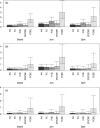Non-song social call bouts of migrating humpback whales
- PMID: 26093396
- PMCID: PMC4474945
- DOI: 10.1121/1.4921280
Non-song social call bouts of migrating humpback whales
Abstract
The use of stereotyped calls within structured bouts has been described for a number of species and may increase the information potential of call repertoires. Humpback whales produce a repertoire of social calls, although little is known about the complexity or function of these calls. In this study, digital acoustic tag recordings were used to investigate social call use within bouts, the use of bouts across different social contexts, and whether particular call type combinations were favored. Call order within bouts was investigated using call transition frequencies and information theory techniques. Call bouts were defined through analysis of inter-call intervals, as any calls within 3.9 s of each other. Bouts were produced significantly more when new whales joined a group compared to groups that did not change membership, and in groups containing multiple adults escorting a female and calf compared to adult only groups. Although social calls tended to be produced in bouts, there were few repeated bout types. However, the order in which most call types were produced within bouts was non-random and dependent on the preceding call type. These bouts appear to be at least partially governed by rules for how individual components are combined.
Figures





References
-
- Bolker, M. B. , Brooks, M. E. , Clark, C. J. , Geange, S. W. , Poulsen, J. R. , Stevens, M. H. H. , and White, J. S. S. (2008). “ Generalized linear mixed models: A practical guide for ecology and evolution,” Trends Ecol. Evol. 24(3), 127–135. - PubMed
-
- Catchpole, C. K. , and Slater, P. J. B. (1995). Bird Song: Biological Themes and Variations ( Cambridge University Press, Cambridge: ), pp. 1–213.
-
- Cerchio, S. , and Dalheim, M. (2001). “ Variation in feeding vocalizations of humpback whales Megaptera novaeangliae from Southeast Alaska,” Bioacoustics 11, 277–295.10.1080/09524622.2001.9753468 - DOI
Publication types
MeSH terms
LinkOut - more resources
Full Text Sources
Other Literature Sources
Miscellaneous

